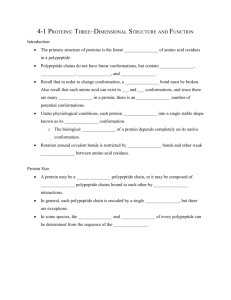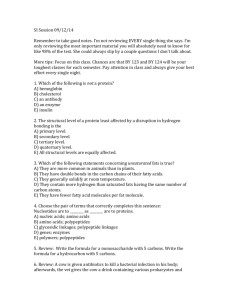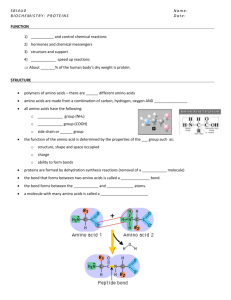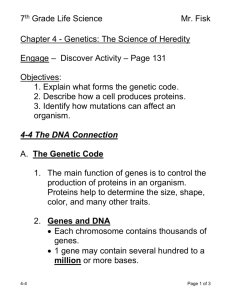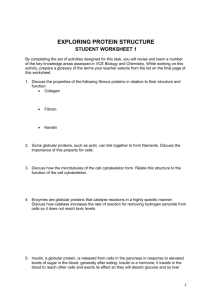Protein Structure Polypeptide: Single chain of amino acids Protein: 1
advertisement
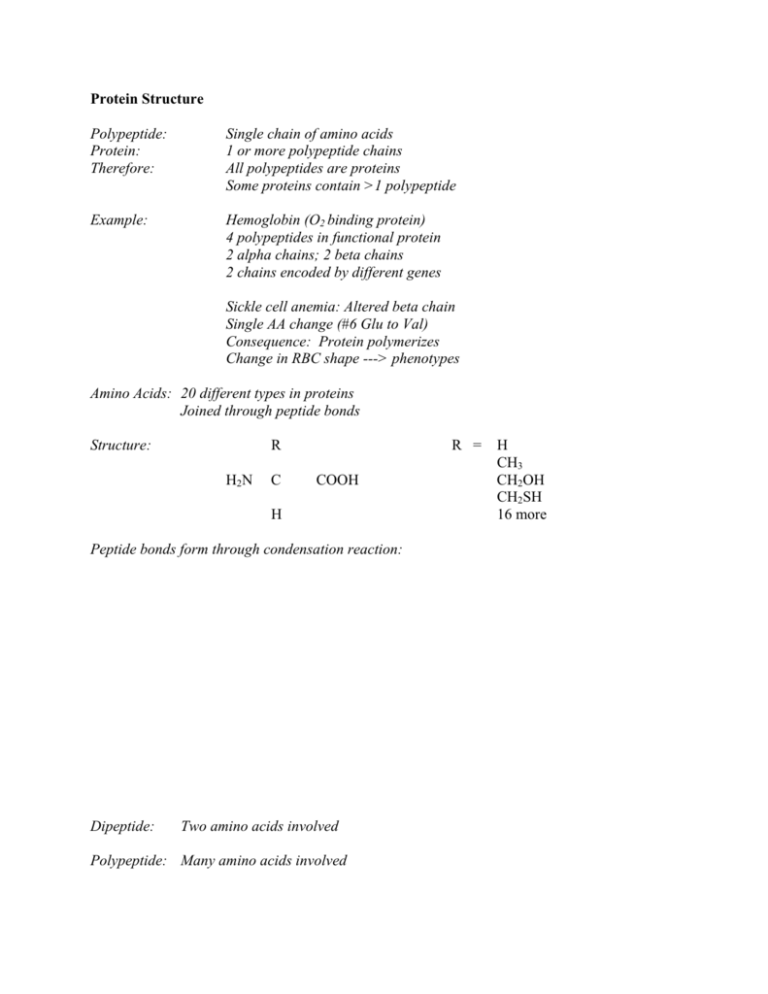
Protein Structure Polypeptide: Protein: Therefore: Single chain of amino acids 1 or more polypeptide chains All polypeptides are proteins Some proteins contain >1 polypeptide Example: Hemoglobin (O2 binding protein) 4 polypeptides in functional protein 2 alpha chains; 2 beta chains 2 chains encoded by different genes Sickle cell anemia: Altered beta chain Single AA change (#6 Glu to Val) Consequence: Protein polymerizes Change in RBC shape ---> phenotypes Amino Acids: 20 different types in proteins Joined through peptide bonds Structure: R H2 N C R = COOH H Peptide bonds form through condensation reaction: Dipeptide: Two amino acids involved Polypeptide: Many amino acids involved H CH3 CH2OH CH2SH 16 more NH2: Amino End (N-terminus) COOH: Carboxyl End (C-terminus) Typical polypeptide: 100 - 1,000+ amino acids Large polypeptides encoded by long mRNAs Amino Acid Nomenclature: Old: New: 3 letter symbol(Gly, Val, Leu, Trp) 1 letter symbol(G, V, L, W) New symbol take less space for genomics work Levels of Protein Structure: Primary: AA Sequence (GVLSWTH etc) Difficult to predict final 3-D shape Secondary: Regular folding of parts of chain Examples: Alpha helix, Beta pleated sheet Determined by H-bonding Tertiary: 3-D shape of single polypeptide H-bonding, Disulfide bonds Hydrophilic/hydrophobic interactions Quaternary: Arrangement of polypeptides in multimeric protein Protein Folding: Essential for Normal Protein Function Partially spontaneous Facilitated by chaperone proteins Targeting Proteins to Proper Location in Cell: Ribosomes on ER: Proteins deposited into lumen N-terminus of polypeptide: Signal sequence Targets protein to proper compartment Later removed (upon arrival at destination) Alter location by changing signal Important in biotechnology Relationship Between Genes and Proteins Alkaptonuria: Heritable metabolic disorder Studied by Garrod (~1900) Single heritable factor Infants: black urine Accumulate homogentisic acid Severity influenced by diet: Increase [Phe] ---> Increase [HA] in affected people No change in “normal” individuals Conclude: Affected individuals cannot metabolize HA Genetic material controls chemical reactions Pheylketonuria (PKU): Related metabolic pathway Common mutation (1 in 11,000 births) Disrupts Phe metabolism Control symptoms by restricting Phe in diet No Nutrasweet (Poly-Phe compound) Beadle and Ephrussi (1930’s) Drosophila mutants with altered eye pigments Wild-type: Red-brown eyes Red + brown pigments Mutants: Bright red eyes Loss of brown pigment Examples: vermilion (v); cinnabar (cn) Approach: Conclude: Transplant larval imaginal disks Mutations disrupt different steps in biosynthesis of brown pigment Beadle and Tatum (1940’s) Auxotrophic mutants of Neurospora Require supplemental nutrient for growth Amino acid, vitamin, nucleoside Wild-type (prototroph) grow on basal media Isolated arginine-requiring mutants Tested growth on citrulline, ornithine Precursors in biosynthetic pathway 3 classes of mutants found: 1. 2. 3. Grew on Arg, Cit, Orn Grew on Arg, Cit Grew on Arg Consistent with proposed pathway: Precursor --> Ornithine --> Citrulline --> Arginine Conclusion: 1 gene encodes 1 enzyme Later: 1 gene : 1 protein; 1 gene : 1 polypeptide Examples of exceptions: Genes encoding RNAs that are not translated Genes encoding RNAs that are differentially spliced So What Exactly is a Gene? Region of nucleic acid (usually ds DNA) Transcription unit: capable of producing RNA Typically encodes single polypeptide Nucleotide sequence in gene determines amino acid sequence in polypeptide Mutations alter phenotype by changing: Nucleotide sequence in gene, mRNA AA sequence in polypeptide Protein function; Cell function Mutations – Alleles – Protein Function Wild-type allele: Most common form in population Usually codes for functional protein; Usually dominant Single copy --> sufficient protein for cell function Mutant allele: Sequence differs from wild type Usually codes for non-functional protein Usually recessive; Many different types in population Simple Dominance (Aa): A: a: Codes for functional protein Codes for defective protein Aa: Mixture of functional and defective proteins Sufficient normal protein for cell function Defective protein does not interfere aa: Only defective protein made Semidominance: Aa: Intermediate phenotype Normal protein insufficient for cell function Recessive Mutant Alleles Differ in Strength: Weak: Partial loss of protein function Often missense mutations; minor change in protein Strong: More complete loss of protein function Disruption of critical protein domains Null: Complete loss of protein function Gene deletions; nonsense mutations Dominant Mutant Alleles: Less common than recessive mutant alleles Usually result in gain of protein function Not masked by wild-type allele Examples of Dominant Mutations: 1. Over-expression of wild-type allele Too much normal protein made Mutations often in promoter, regulatory regions 2. Inappropriate expression of wild-type allele Wrong place or wrong time 3. Production of altered protein with novel function Example: Enzyme with new substrate specificity Effect seen in presence of normal protein product 4. Altered protein antagonistic to normal protein Defective protein interferes with normal protein

